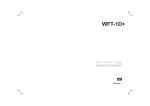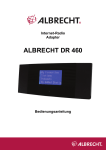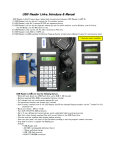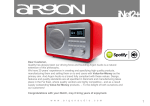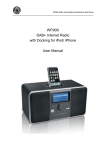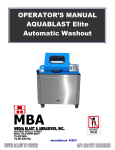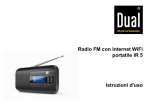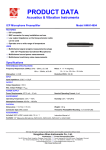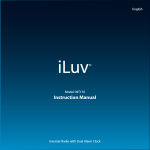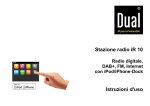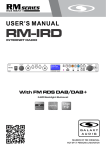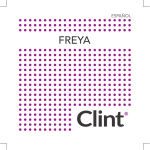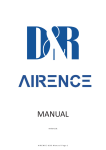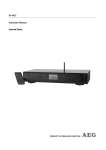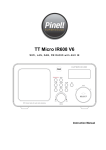Download Complete English language User Guides for L1 1
Transcript
English …it´s all about listening Instruction Manual Internet/DAB/FM Radio Classic series 1 www.clintdigital.com English …it´s all about listening CAUTION TO PREVENT FIRE OR SHOCK HAZARD, DO NOT USE THIS PLUG WITH AN EXTENSION CORD, RECEPTACLE OR OTHER OUTLET UNLESS THE BLADES CAN BE FULLY INSERTED TO PREVENT BLADE EXPOSURE. TO PREVENT FIRE OR SHOCK HAZARD, DO NOT EXPOSE THIS APPLIANCE TO RAIN OR MOISTURE. The lightning flash with WARNING: The exclamation point arrowhead symbol, within an To reduce the risk of electric within an equilateral equilateral triangle is intended shock, do not remove cover triangle is intended to to alert the user to the (or back). No user serviceable alert the user to the presence of insulated parts are inside. Refer presence of important ‘dangerous voltage’ within the servicing to qualified operating and product’s enclosure that may personnel. maintenance (servicing) be of sufficient magnitude to instructions in the constitute a risk of electric literature accompanying shock to persons. the appliance. IMPORTANT SAFETY INSTRUCTIONS 1.) Read these instructions. 2.) Keep these instructions. 3.) Read all warnings. 4.) Follow all instructions. 5.) Do not use this apparatus near water. 6.) Clean only with dry cloth. 7.) Do not block any ventilation openings. Install in accordance with the manufacturer’s instructions. 8.) Do not install near any heat sources such as radiators, heat registers, stoves, or other apparatus (including amplifiers) that produce heat. 9.) Protect the power cord from being walked on or pinched particularly at plugs, convenience receptacles, and the point where they exit from the apparatus. 10.) Only use attachments / accessories specified by the manufacturer. 11.) Unplug this apparatus during lightning storms or when unused for long periods of time. 12.) Refer all servicing to qualified service personnel. Servicing is required when the apparatus has been damaged in any way, such as power-supply cord or plug is damaged, liquid has been spilled or objects have fallen into the apparatus, the apparatus has been exposed to rain or moisture, does not operate normally, or has been dropped. 13.) This appliance shall not be exposed to dripping or splashing water and no object filled with liquids such as vases shall be placed on the apparatus. 14.) Do not overload wall outlet. Use only power source as indicated. 15.) Use replacement parts as specified by the manufacturer. 2 www.clintdigital.com English …it´s all about listening Welcome Thank you for purchasing L1. Your L1 is a new digital radio which will provide you with hours of music enjoyment with simple, convenient access to thousands of Internet radio stations worldwide and furthermore music streaming options and also DAB radio (Digital Audio Broadcasting) and FM with RDS. No matter whether you are in Zürich and want to listen to Brazilian music, or select a genre such as classical music, hard rock or jazz, the L1 brings you home the radio station of your choice. Table of contents 1. Content of package ··············································································· Page 4 2. Before you start ··················································································· Page 4 2.1 Difference between the Internet Radio Portal and Radio Station················ Page 5 3. Overview of L1 ····················································································· Page 6 3.1 Front panel ······································································ Page 6 3.2 Back panel ······································································· Page 7 4. General menu navigation / Menu Structure ·············································· Page 7 5. Menu structure ····················································································· Page 8 6. General info and settings ······································································· Page 9 7. Turning on L1 ···················································································· Page 11 8. Setting up the L1················································································ Page 11 8.1 Setting up the language ·················································· Page 11 8.2 Setting up the time and date············································ Page 11 8.3 Connecting to a network ·················································· Page 12 8.4 Internet radio portal registration ······································ Page 15 8.5 Setting up Music server ··················································· Page 16 8.6 Sharing media from Windows Media Player ························ Page 17 8.7 Sharing folders on a Windows PC ······································ Page 18 8.8 Sharing folders on a non-Windows computer······················ Page 19 8.9 Setting up L1 to work with shared folders ·························· Page 19 9. Internet radio mode ············································································ Page 20 9.1 Last listened ·································································· Page 21 9.2 Presets ·········································································· Page 21 9.3 Favourites ····································································· Page 21 9.4 Browse ·········································································· Page 22 9.5 Search ·········································································· Page 23 9.6 My added stations ·························································· Page 23 9.7 Now playing information ·················································· Page 24 10. Music player mode ············································································ Page 24 10.1 Shared Media (from media server) ·································· Page 24 10.2 Shared Folders (from media server) ································ Page 25 10.3 Now playing information ················································ Page 26 11. DAB radio mode mode······································································· Page 27 11.1 Scanning for stations····················································· Page 27 11.2 Selecting stations ························································· Page 27 11.3 Now playing information ················································ Page 28 11.4 Settings ······································································· Page 28 12. FM radio mode ················································································· Page 29 12.1 Selecting stations ························································· Page 29 12.2 Now playing information ················································ Page 29 12.3 Settings ······································································· Page 30 13. iPod mode ························································································ Page 31 14. Info and Error Messages ···································································· Page 32 15. Troubleshooting – connecting to an internet station ······························ Page 33 16. FAQ ································································································ Page 34 3 www.clintdigital.com English …it´s all about listening 1. Content of package Please make sure that the following contents are included in the package: 1. 2. 3. 4. 5. L1 Adaptor - Main unit Power supply ipod dock Cable L1 User Manual & multi-lingual Quick Guide LA N LIN E OU T DC -IN M od In te el :L 1(L M usrn et /D ok i se AB rie ic Cl in St re /F M s) am t in g Ra di o Vi ew Au di fu o w ith DK -3 M ed ia n 52 0 Ap Fa ru S Ne ed w w he lp m w .c ? lin td ig ita l.c om LIN E IN 2. Before you start Before you can use your internet radio, you need the following: 1. A broadband internet connection. 2. A wireless access point connected to your broadband internet. Via a router is recommended. 3. If your wireless network is configured to use WEP (Wired Equivalent Privacy) or WPA (Wi-Fi Protected Access) data encryption, it is important that you know your WEP or WPA code to connect to your network. 4. PC. 4 • Windows Media Player (WMP) 11 can be set up to enable streaming music files from the PC to the radio. • Alternatively, Windows shared folders can be used if WMP is not installed in the PC. • The PC can also be used to customise the radio’s favourites via the Frontier Silicon internet radio portal. www.clintdigital.com English …it´s all about listening 2.1 Difference between the Internet Radio Portal and Radio Station There might be some confusion with regards to the difference between the Internet radio portal and the actual internet radio stations. Internet Radio Portal The portal is the content aggregator which maintains links to all the available internet radio stations. It can be considered to be an ‘address book’, listing the address of all the internet radio stations and regularly updated with new ones. When a user navigates through the radio menus, the list of stations is returned by the Portal. The portal used is : http://www.wifiradio-frontier.com Internet Radio Station The station is the actual website which contains the selected station audio stream. Once a user has selected a station through the Portal, the radio then connects directly to the station. Depending on your wireless router the internet radio should work anywhere within up to 20-30 meters of the wireless access point. Before continuing, make sure that your wireless access point is turned on and connected to your broadband internet. Please refer to your wireless access point manual to get this part working. 5 www.clintdigital.com English …it´s all about listening 3. Overview of your L1 After taking your L1 out of the package, please spend some time to familiarize yourself with its features. 3.1 Front Panel Speaker Volume Knob LCD Display Power Button Select Knob Preset Button Menu Button Mode Button Info Button Back Button Description of functions for each buttons on the front. Power Rew Play/Pause Forward 6 Preset Stored Alarm Press to set alarms Sleep Press to set sleep timer - Off-15-30-45-60 minutes Info Info (shift between different informations) Menu Menu (Press to access Menu) Select ↑ Scroll up through a menu or station list Select ↓ Scroll down through a menu or station list +Vol Increase volume - Press to MUTE sound -Vol Decrease volume - Press to MUTE sound Back As main control Back button Mode Press to switch between(DAB/FM/Internet Radio etc.) www.clintdigital.com English …it´s all about listening 3.2 Back Panel DAB Antenna port Model:L1(Loki series) Internet/DAB/FM Radio with n Music Streaming f Clint Audio ViewMedia ApS DK-3520 Farum Need help ? www.clintdigital.com LAN LINE OUT DC-IN LINE IN Connection for power supply Connectors on this current model is: 1 x stereo mini jack output for Headphone or Line out use. (not shown on above picture) 4. General menu navigation / Menu Structure The Wi-Fi radio features three types of menu. These are: • The Main menu This is the top level menu which allows users to enter the different modes, setup the radio, and view information about the radio (for example software version, product ID). • The Internet Radio Station List menu This is the menu that allows users to access the different internet radio services. This menu comes direct from the Internet Radio portal. • The Mode menus for the various modes The mode menus are so called because they show the functions available within the context of each of the modes. Pressing the MENU button anytime will take you the mode menu of the relevant mode the radio is currently in. Each context menu provides an entry called main menu which takes you back to the MAIN menu. To navigate to the different menus you must use the SELECT knob. The SELECT knob can be turned and pressed. Turning the knob will scroll through the different selections and pressing SELECT will confirm choice. This is general for all menu items. Use BACK button to go to previous menu. For example to navigate to the MAIN MENU while in INTERNET RADIO MODE press MENU button and turn SELECT knob untill MAIN MENU is selected. Press the SELECT knob to enter MAIN MENU. Pressing MENU on front panel will take you to the Context Menu of the present mode of L1 (Internet radio, etc.) 7 www.clintdigital.com English …it´s all about listening 5. Menu Structure (not all features shown are available for this model) Standby Modes and menus overview map Clock/alarms Standby Alarm/snooze Internet radio IR Mode menu Menu Last listened Station list System settings Main menu Splash/ Now playing Select > > > Back > > > Select Mode Music player Splash/ Now playing MP Mode menu Menu Mode SIRIUS Splash/ Now playing Shared media USB playback My playlist Repeat play:off Shuffle play:off System settings Main menu Back > > Submenus Option Option Option Option Option Menu Option Option Menu Menu Option Menu Menu Menu Menu Menu SIRIUS Mode menu Menu Channel list SIRIUS setup System settings Main menu > > > > Select Select > > > > > > > > Back Back Mode System settings Pandora Splash/ Now playing Pandora Mode menu Menu Channel list Pandora setup System settings Main menu > > > > Select Back Equaliser Network Time/date Languages Factory reset Software update Setup wizard Info > > > > Mode Select Last.fm Splash/ Now playing Menu Channel list Last.fm setup System settings Main menu > > > > Select Back Mode DAB radio Splash/ Now playing DAB Mode menu Menu Mode FM radio Station list Local scan Full scan Manual tune Prune invalid DRC Station order System settings Main menu > > Select Back Main menu Internet radio Music player Rhapsody SIRIUS Pandora Last.fm DAB radio FM radio iPod Aux in Sleep Alarms System settings > > > > FM Mode menu Menu Scan settings Audio settings System settings Main menu Splash/ Now playing Select > > Back Mode iPod iPod Mode menu Menu Splash/ Now playing Select System settings Main menu > > Back Mode Aux in Aux in Mode menu Menu Splash/ Now playing Select System settings Main menu > > Back Mode 8 Back Last.fm Mode menu www.clintdigital.com > English …it´s all about listening 6. GENERAL INFO and SETTINGS Conventions used in this manual Button (press) Physical button on the keypad Option (select) Menu option shown on the display Name Menu, screen or other name L1 has numerous features which require a small degree of setup before users are able to fully use all the functionalities of the radio. The Main Menu System Setup menu has a series of options that allow systemwide settings to be altered. These settings are: L1 has basically three types of menu. Use the Select control to step through and select options. A scroll bar on the right of the screen shows if there are further options above or below those visible. In addition, each mode menu has two final options: System settings > and Main menu >. The ‘>’ indicates options leading to further menus. The System settings menu allows access to system settings and information such as network, time, language and software update. Menus with more options than will fit on one screen have a scroll bar to the right. The Main menu allows access to all modes plus sleep and timer functions. Some menus, for example the System settings menu, have several submenus. 9 www.clintdigital.com English …it´s all about listening Dialogue screens Dialogue screens are shown to allow the user to change settings. They vary in complexity from simple Yes/No options up to the scrollable network password input screen. As with menus, the selected item is shown with a white background. Dialogue screens mark the current setting with an asterisk (*). Display screens L1 has basically three types of display screen: The Standby screen shows the time, date and any active alarm times. As you cycle through the play modes using Mode , L1 shows a splash screen for each mode. After one second, L1 enters the selected mode and tries to start playing the last station or track that was playing in that mode. If this is not possible, L1 will try to connect to the selected source by scanning for stations, networks, or prompting for user input as appropriate. The Now playing screen shows information about the audio source and track now playing, where available. In addition, there are screens for information such as volume, mute and information/error messages. 10 www.clintdigital.com English …it´s all about listening 7. Turning on L1 Preparing L1 for operation: 1. Place L1 on a flat surface. 2. Connect power cable and turn on the radio. 8.Setting up the L1 8.1 Setting the language The default language is English. To change this, select Menu > System settings > Languages > then select your language. 8.2 Setting the time/date The time and date can be updated manually or automatically. Setting manually is simpler, but the time and date are lost when power is removed. Setting to update automatically is a little more complicated at first, but the time and date are automatically synchronised with external clocks, so it should only need to be done once. Auto update is generally more accurate. To enter the Time settings menu, select Menu > System settings > Time/date > Manual update Select Set time/date > The date and time are displayed as ddmm-yyyy and hh:mm AM/PM with the first value, dd active (flashing). Adjust each value with the Select control. As each value is adjusted, the next value becomes active and flashes. When you select the final value (minutes or AM/PM, depending on whether the clock is set to 12 or 24 hour mode), the display reverts to the now playing screen and shows the newly updated time. 11 www.clintdigital.com English …it´s all about listening Auto update Auto update works with data sent over the network (This function is only available in specific models). The clock is only updated when in a corresponding mode, so it is best to select a mode you use regularly. o Network uses a time signal sent from the Frontier Silicon Internet radio portal when in Internet radio or Music player modes. 1. Select Auto update > then select Update from Network. 2. Set your time zone through Set timezone >. 3. If your country uses daylight saving, the automatically updated time may be wrong by one hour. When daylight savings are in effect (during the summer), turn on the Daylight savings option through Daylight savings > ON L1 will auto-update from the selected source when time information is available. 12/24 hour display To change between 12 and 24 hour display, select Set 12/24 hour and then select your preference. 8.3 Connecting to a network For Internet radio and Music player modes, you need a network connection. To connect L1 to your network, you need a Wi-Fi wireless router, together with password key if set. For Internet radio, Internet software and automatic time/date updates, the router must have a broadband Internet connection. When you select Internet radio or Music player mode, L1 tries to connect to a ne twork. If this is the first time it has tried to connect, or if the stored networks are not accessible, the Network wizard starts. To run the Network wizard manually, select Menu > System settings > Network > Network wizard. Once the wizard starts, enter the following information: o If not already set, WLAN region (select country/region from list), o Network name (select your network from the list), o If connecting to an encrypted wireless network, the key (password). To enter your key, use the Select control to move the cursor through the characters and select. As each character is selected, the key is built up near the top of the display. 12 www.clintdigital.com English …it´s all about listening There are three options accessible by turning Select back before the first characters (0123…) – Backspace, OK and Cancel. You can also use the Back button to erase characters. Once you have completed entering the key, select OK, and L1 will try to connect to the selected network. If connecting fails, L1 returns to the password entry screen. If the network connection is lost, L1 automatically tries to reconnect. Network profiles L1 remembers the last four wireless networks it has connected to, and automatically tries to connect to whichever one of them it can find. You can see the list of registered networks through Menu > System settings > Network > Network profile >. From here you can delete unwanted networks by turning and pressing Select then confirming delete Yes. Other options There are also other options for viewing and manually altering network settings from Menu > System settings > Network >. These options are not normally necessary, but users experienced with networking may find them useful for diagnosing and fixing network problems. 13 www.clintdigital.com English …it´s all about listening Equaliser Several preset EQ modes are available; also a user-defined setting. To adjust the EQ, select Menu > System settings > Equaliser. You can then choose from a variety of preset modes or create your own, with custom bass, treble and loudness settings. 14 www.clintdigital.com English …it´s all about listening 8.4 Internet radio portal registration L1 operates with The Frontier Silicon Internet radio portal website which allows you to organise your favourites lists and also listen to Internet radio on a computer. To register your L1 with the portal, first get your radio’s unique portal access code by selecting Menu > Station list > Help > Get access code >. Write down the access code. Note: Do not confuse the portal access code with the Radio ID (from Menu > System settings > Info.) On an internet-connected computer, access the portal website at www.wifiradio-frontier.com. If this is your first visit to the portal, register for a new account, entering the following information: o access code, o password, o your e-mail address, o radio model (L1). If you already have an account and wish to add an additional radio, log in to your account and select My preferences > Add another Wi-Fi radio. 15 www.clintdigital.com English …it´s all about listening Once your radio is registered with the portal, you can immediately use the favourites and added stations features. 8.5 Setting up a music server In order for L1 to play music files from a computer, the computer must be set up to share files or media. uPnP media sharing allows devices like L1 to play music from a shared media library, navigating through tag menus such as Artist, Album or Genre. If you are running a suitable server system such as a PC with Windows Media Player 10 or later (WMP), and your music library is well-tagged, then it is recommended to use media sharing. Only the uPnP server needs to be set up. Folder sharing (CIFS) allows devices like L1 to browse folders on a network drive for audio files. This is a good alternative if you cannot use media sharing, and an alternative way to find files even if you have media sharing set up. The computer needs to be set up to share folders, and if this is done with password control, you also need to enter the user name and password into L1. 16 www.clintdigital.com English …it´s all about listening 8.6 Sharing media with Windows Media Player NOTE! As new versions of Windows and WMP are available the below info may be slightly different. Please refer to your Windows manual for more information on sharing media. The most common UPnP server is Windows Media Player (10 or later). To set up WMP for media sharing, perform the following steps: 1. Ensure that the PC is connected to the network. 2. Ensure that the radio is powered on and connected to the same network. 3. In WMP, add to the media library the audio files and folders you want to share with L1 (Library > Add to Library…). 4. In WMP, enable media sharing (Library > Media sharing…). L1 is listed as “Unknown Device”. Make sure that the radio has access to the shared media by selecting it and clicking Allow. You can also set a name for the shared media in Settings… Click OK to close the dialogue boxes. The PC is now ready to stream the music to the radio. 17 www.clintdigital.com English …it´s all about listening 8.7 Sharing folders on a Windows PC To share folders in Windows, the PC must first be a member of a domain or workgroup. Once this is setup, folders can be shared from Windows Explorer (My Computer). Domain/workgroup configuration The Domain configuration item can be found on a Windows XP machine as follows: 1. From the start menu, select Control Panel > System > Computer Name tab. The Computer’s Domain or Workgroup is displayed in this tab. 2. If the PC is not a member of any Domain or Workgroup then one must be joined. To do this click on the change button and enter the name of the domain (the default for Windows XP is MSHOME). 3. A reboot of the PC may be prompted if the Domain or Workgroup has been changed. Setting up a new user account (Windows XP) The Wi-Fi Radio requires a user account to be set up on each PC that you wish to browse. By default most PCs have at least one user account. The user name and password (optional) need to be the same on each PC, as the Internet Radio only stores one user name and one password. For windows XP this can be set up as follows: 1. From the start menu, select Control Panel > User accounts. 2. From this screen click ‘Add …’, and enter the new user name and the Domain/Workgroup setting noted above. Select the type of user (restricted) and then select finish. 3. Select the user just created, select ‘Reset Password …’ and enter a password for this user. 4. Note the user name and password. Note: For Windows Vista: Users have to turn on the Guest account via manage user accounts in the control panel, then add access to either ‘Everyone’ or ‘Guest’ on the shared drive. You could create a new account for the internet radio, with a password, if you are concerned about security. The Guest account has no password by default, so L1 will connect to it from its factory default settings. Configuring a shared drive From the Start menu select My Computer or Windows Explorer and navigate to the directory you wish to share. Right click on the folder and select Sharing and Security. Configure the shared drive as readonly, and ensure that the user created above has read access to the share. 18 www.clintdigital.com English …it´s all about listening 8.8 Sharing folders on non-Windows computers It is beyond the scope of this manual to describe how to share folders on all computer systems. Please refer to your operating system documentation to find out how to share folders on nonWindows computer systems. If you configure shared folders with user name and password security, note these values. 8.9 Setting up L1 to work with password protected shared folders To set up L1 to playback audio stored on password-protected shared network drives, you need to enter a user name and password. To do this, from Music player mode, select Menu > PC settings > Username and enter the user name then PC settings > Password and enter the password. Enter a keyword by selecting characters then OK. The user name and password entry screens are similar in operation to the Wi-Fi password entry screen. The default user name is ‘guest’. 19 www.clintdigital.com English …it´s all about listening 9.Internet radio mode L1 can play thousands of radio stations and podcasts from around the world through a broadband Internet connection. When you select Internet radio mode, L1 contacts the Frontier Silicon Internet radio portal to get a list of stations, organised into different categories like Country, Most popular and Genre. Once you select a station, L1 connects directly to that station. The portal also enables multiple lists of favourite stations that you can personalise, for example Andy’s stations, Jo’s favourites, Talkshows. To use the favourites feature, register your radio with the portal website as described on page 14. If you have several Frontier Silicon opeated radios, you can register them all on the same account so that each radio has access to your favourites lists. It is possible to add favourites either directly through L1 or through any computer with a web browser. To enter Internet Radio mode, either press Mode until the display shows Internet Radio or select Menu > Main menu > Internet Radio. Note: The station list menu is provided from the Internet radio portal, so it is only accessible when L1 is connected to the Internet. Station lists and submenus may change from time to time. There are several ways of selecting stations. Directly from the radio: o o Last listened, Presets. From the portal through the Menu > Station list > menu: o Favourites lists, o Browse by Country, Genre, Most popular, Newest, o Search by keyword, o My added stations. If you are already listening to an Internet radio station, you can press Back rather than Menu to quickly return to the last visited branch of the menu tree. For example, suppose you were listening to New Orleans Radio through the browse facility as described in section 0 under. Pressing Back would return you to the Highlighted Blues stations menu. Pressing Back again would return you to the Blues menu, and so on. 20 www.clintdigital.com English …it´s all about listening 9.1 Last listened When Internet radio mode restarts, the last-listened station is selected. To select another recenly used station, select Menu > Last listened then one of the stations listed. Most recent stations appear at the top of the list. 9.2 Presets Presets are stored in the radio and cannot be accessed from other radios. To store an Internet radio preset, press and hold Preset until the display shows the Save preset screen. Select one of the 10 presets to save the currently playing station. To select a preset, press Preset briefly, then select one of the listed preset stations. When a preset station is playing, it shows Pn (P1, P2 etc) in the bottom of the screen. Note: Operation of presets is identical for Internet radio, DAB and FM. 9.3 Favourites Favourites are stored with the Internet radio portal, and are available through all Internet radios registered on the same account. Before favourites can be used, the radio has to be registered with the Internet radio portal (see page 14). To store a playing station as a favourite from L1, simply press Select . The selected station appears in the default favourites list Stations. To select a favourite, select Menu > Station list > My favourites > [Favourites list] > [Station]. 21 www.clintdigital.com English …it´s all about listening 9.4 Browse To browse Internet broadcasts, select Menu > Station list > then either Stations > or Podcasts >. Browse through the menus to find broadcasts. 22 www.clintdigital.com English …it´s all about listening 9.5 Search You can also search through Internet broadcasts for stations or podcasts with particular keywords in their title. To search, select Menu > Station list > then either Stations > or Podcasts > Enter a keyword by selecting characters then OK. The search entry screens are similar in operation to the Wi-Fi password entry screen. Select a broadcast from the list. For podcasts, you may be able to select a particular episode. 9.6 My added stations Even though the Internet radio portal contains thousands of stations, you may want to listen to stations not listed. You can add your own stations via the portal. These added stations are accesible from L1 by selecting Menu > Station list > My added stations > [Station]. See section 8.4 for more detailed information on adding stations. 23 www.clintdigital.com English …it´s all about listening 9.7 Now playing information While the stream is playing, the screen shows its name and description. To view further information about the stream, press Info . Each time you press Info , another set of information is displayed, cycling through description, format/location, reliability, bit rate/codec/sampling rate, playback buffer and today’s date. 10.Music player mode (network and USB (Optional)) Music player mode plays audio files such as MP3s or WMAs from a computer on the local network, or from a USB Flash stick or hard drive (Optional). To enter Music player mode, either press Mode until the display shows Music player or select Menu > Main menu > Music player. Once in music player mode, press Menu , then select either Shared media, Shared folders or USB mass storage (Optional). If you are already playing a music file, you can press Back rather than Menu to quickly return to the last visited branch of the menu tree. For example, suppose you were listening to the track Heat by the artist 50 Cent through browsing shared media as described in section 0 under. Pressing Back would return you to the track listing for the album Get Rich or Die Tryin’. Pressing Back again would list all 50 Cent albums. Pressing Back again would list all album artists, and so on. 10.1 Shared media (from media server) Select Menu > Shared media > If you have set up shared media (as described on page 17), you should see an entry consisting of <computer name>: <Shared media name>, for example JB-Laptop: Audio. If you have more than one computer sharing media, the alternatives are listed. Select the shared media you want to play. 24 www.clintdigital.com English …it´s all about listening From this point on, the menus are generated from the shared media server (typically Windows Media Player). The first menu shows a list of media types, for example Music, Video, Pictures and Playlists. L1 can only play music and playlists. There is also a search function, which finds tracks in a similar way to Internet radio search ( please see specific paragraph for this issue). From Music, there are numerous ways of selecting tracks, including: o Genre, o Album, o Rating. o Artist, o Composer, Once you have found a track you want to play, press Select . L1 will play the selected track, then any further tracks that were listed on the same screen; usually this is the rest of the album. 10.2 Shared folders (from network or USB mass-storage device) Selecting shared folders To play audio from shared folders, select Menu > Shared folders > If you have set up shared folders you should see an entry consisting of <Computer name>: <Shared folder name>, for example JB-Laptop: Audio. If you have more than one shared folder, the alternatives are listed. Select the shared folder you want to browse. Selecting a USB mass-storage device (Optional) To play audio from a USB mass-storage device such as a USB Flash stick or USB hard drive, Select Menu > USB Mass Storage. 25 www.clintdigital.com English …it´s all about listening Browsing folders From this point on, the menus are generated from the shared folders on the remote computer.You can browse the music library through its folder tree with the Select control and Back button. The display shows folder and file names (not necessarily track names). Once you have found a track you want to play, press Select . L1 will play the selected track, then any further tracks in the same directory, in alphanumeric order. 10.3 Now playing information While the track is playing, the screen shows its track and artist (UPnP) or file name and folder (CIFS/USB). At the bottom of the screen, an icon indicates UPnP, CIFS or USB depending on the source. To view further information about the stream, press Info . Each time you press Info , another set of information is displayed, cycling through: 26 o UPnP: artist, album, URL, bit rate/codec/sampling rate, playback buffer and today’s date, o CIFS/USB: folder, path, bit rate/codec/sampling rate, playback buffer and today’s date. www.clintdigital.com English …it´s all about listening 11. DAB radio mode DAB radio mode receives DAB/DAB+ digital radio and displays information about the station, stream and track playing. To enter DAB mode, either press Mode until the display shows DAB Radio or select Menu > Main menu > DAB. 11.1 Scanning for stations The first time you select DAB radio mode, L1 automatically performs a full scan to see what stations are available. You may also need to start a scan manually to update the list of stations for one of the following reasons: o Available stations change from time to time. o If reception was not good for the original scan (for example the antenna was not up), this may result in an empty or incomplete list of available stations. o If you have poor reception of some stations (burbling), you may wish to list only stations with good signal strength. To start a scan manually, select Menu > Full scan. Once the scan is complete, the radio shows a list of available stations. 11.2 Selecting stations To listen to or change a station, turn the Select control to view a list of stations and press to select. Once selected, the station plays and the screen shows information about the station, track or show as broadcast. 27 www.clintdigital.com English …it´s all about listening Presets To store a DAB preset, press and hold Preset until the display shows the Save preset screen. Select one of the 10 presets to save the currently playing station. To select a preset, press Preset briefly, then select one of the listed preset stations. When a preset station is playing, it shows Pn (P1, P2 etc) in the bottom right of the screent. 11.3 Now playing information While the stream is playing, the screen shows its name and DLS information broadcast by the station such as programme name, track title and contact details. Stereo broadcasts are indicated with an icon at the top of the screen. To view further information about the stream, press Info . Each time you press Info , another set of information is displayed, cycling through DLS information, programme type, ensemble name/frequency, signal strength/error rate, bit rate/codec/channels and today’s date. 11.4 Settings Dynamic range compression (DRC) If you are listening to music with a high dynamic range in a noisy environment (for example classical music while cooking), you may wish to compress the dynamic range. This makes quiet sounds louder, and loud sounds quieter. To change DRC, select Menu > DRC > then DRC off, low or high. Station order You can choose the order of the DAB station list to be either Alphanumeric, Ensemble or Valid. Ensemble lists groups of stations that are broadcast together on the same ensemble, for example BBC or South Wales local. Valid lists valid stations first, alphanumerically, then off-air stations. To change station order, select Menu > Station order > then Alphanumeric, Ensemble or Valid. Choose Prune Invalid to Remove all invalid stations. 28 www.clintdigital.com English …it´s all about listening 12. FM radio mode FM radio mode receives analogue radio from the FM band and displays RDS (Radio Data System) information about the station and show (where broadcast). To enter FM mode, either press Mode until the display shows FM Radio or select Menu > Main menu > FM. 12.1 Selecting stations To find a station, press Select . The frequency display starts to run up as L1 scans the FM band. Alternatively, you can scan up or down by holding the >> or << buttons or tune manually with quick presses, or by turning the Select control. Once a station is tuned in, the Now playing screen shows the station name and any other information available on RDS. If no information is available, just the frequency is shown. Presets To store an FM preset, press and hold Preset until the display shows the Save preset screen. Select one of the 10 presets to save the currently playing station. To select a preset, press Preset briefly, then select one of the listed preset stations. When a preset station is playing, it shows Pn (P1, P2 etc) in the bottom right of the screen. 12.2 Now playing information While the stream is playing, the screen shows its frequency, or if RDS information is available, station name and any further RDS information such as programme name, track title and contact details. Stereo broadcasts are indicated with an icon at the top of the screen. To view further information about the broadcast, press Info . Each time you press Info , another set of information is displayed, cycling through further RDS information, frequency and today’s date. 29 www.clintdigital.com English …it´s all about listening 12.3 Settings Scan settings By default, FM scans stop at any available station. This may result in a poor signal-to-noise ratio (hiss) from weak stations. To change the scan settings to stop only at stations with good signal strength, select Menu > Scan setting > Strong stations only? > Yes. Audio settings By default, all stereo stations are reproduced in stereo. For weak stations, this may result in a poor signal-to-noise ratio (hiss). To play weak stations in mono, select Menu > Audio setting > FM weak reception: Listen in mono only > Yes. 30 www.clintdigital.com English …it´s all about listening 13. iPod mode L1 has an iPod dock, which is compatible with all Apple iPods. Once an iPod is docked, L1 can recharge the iPod, control it through the keypad or remote control, and play the iPod’s music library through the speakers. monitor. L1 includes the Apple coprocessor so that it can play video from latest iPod models. To enter iPod mode, 1. Place the iPod on the docking station. L1 asks if you want to switch to iPod mode. Select YES. 2. To show video from the iPod, connect a TV or monitor to the s-video or composite video out sockets. 2. If you already had the iPod connected to L1, either press Mode until the display shows iPod or select Menu > Main menu > iPod. When iPod mode is selected, L1 switches on the iPod. 3. Press || > to play or pause. The track now playing is displayed on the iPod. You can use << and >> to move through tracks. Press and hold to rewind or fast forward and press quickly to select previous or next track. Now playing information When in iPod mode, the screen shows docked status (‘Docked’ or ‘Insert iPod’) Once the iPod is authenticated, the display shows the track name. Note: if authentication is taking longer than 30s, try removing the iPod and reinsert. To view further information, press Info . Each time you press Info , another set of information is displayed, cycling through track, authentication status (‘Processing…’, ‘Success’ or ‘Failed’), progress bar, artist, album, and today’s date. 31 www.clintdigital.com English …it´s all about listening 14. Info and Error Messages The following is a description of the info and error messages that the WiFi radio could possibly display. Massage Type Description Failed to connect Error Network error Format error 32 Error Error Seen when a Wi-Fi network related error occurs. Some examples of circumstances which will trigger a ‘failed to connect’ are : - radio fails to connect to Wi-Fi network - wrong network security key entered Seen when a server/connection related error occurs. Some examples of circumstances which will trigger a ‘network error’ are : - radio fails to connect to Wi-Fi network - radio fails to connect to internet radio portal - radio fails to connect to a radio station - radio’s was streaming a station and connection fails midway through the streaming - radio fails to connect to a PC for streaming music Seen when the radio has problem playing the media due to unsupported format type. Some examples of circumstances which will trigger a ‘format error’ are : - Radio tunes to a internet radio station which is being transmitted using an audio codec not supported by the radio (i.e. AAC+). - Radio tries to play a music file from a PC which is in a format not supported Connecting… Info Seen when the radio tries to establish connection with a network, server, portal, station. Loading… Info Seen once the radio has established connection, and starts buffering the station/stream. Playing Info Seen once the radio has completed connecting, and loading, and starts playing the stream. This is the point when the station becomes audible. www.clintdigital.com English …it´s all about listening 15. Troubleshooting – connecting to an internet station Radio attempts to connect to the wifi network [Connecting…] Connected? Possible Cause Checklist no Failed to connect 1. Wifi router might be down 2. Wrong network key entered Check if PC is able to connect to the wifi network and the network key (if in use) is correct no Network error 1. Broadband internet connection might be down. 2. Internet portal (fs.vtuner.com) might be down Check if PC is able to access the internet radio portal (http://wifiradiofrontier.com) when connected to the same wifi network Network error 1. Selected internet radio station might be down Go to the internet radio portal (http:// fs.vtuner.com) and try to play the station from the PC to see if problem is due to the station or your network Format error 1. Radio does not support the format used by the internet radio station Go to the internet radio portal (http:// wifiradiofrontier.com) and try to play the station from the PC to see if problem is due to the station or the radio yes Radio attempts to connect to internet portal to get internet radio listings [Please Wait] [Loading…] Connected? yes Show Internet radio top-level menu ------------------My Favourites Stations Podcast My Added Stations ------------------User selects a station to be played Radio attempts to connect to the internet radio station [Connecting…] Connected? no yes Radio attempts to play the radio stream [Loading…] Successful? no yes [Playing] 33 www.clintdigital.com English …it´s all about listening 16. FAQ Question: Answer: What do I need to start using the Radio? How do I connect the radio to my wireless network? To access Internet radio mode, use the “MODE” key to set it to Internet radio mode. Then follow the on-screen instruction to choose either GENRE or LOCATION to select. Important: You would need a ADSL broadband connection to use the Internet Radio mode. And you would need to have a Wireless router/Acess Point to connect wirelessly. On initial power up the radio will prompt you to “Scan for network”. After a brief scan a list of all available networks will occur and allow you to select which one you wish to use. If the selected network is not configured to request a password, you can immediately access your wireless network. It will not acknowledge my encryption key? It will not connect to my wireless network? If the selected network is configured to request a password (WEP key), you will be asked to enter the key at this point. Remember to write it with capital letters if needed. It is worth checking the following if you are experiencing problems connecting to your wireless network: Check that you are using the correct WEP Key / passphrase, remember this will be case sensitive. Check if your router connected to the internet. The easiest way to check this is if you have a computer on the same network, if it can access the internet we know the router is connected to the internet. Check that your WIFI network allows other devices to get access. Then reboot radio and try again. Can I receive Radio on my Radio if no Internet connection is available? 34 No. Since this is an internet radio only this is not unfortunately not possible. www.clintdigital.com English …it´s all about listening Why won’t my Radio playback my media files? If you are experiencing difficulties in playing media files, it is worth checking the following: • • • I can see my music listed on the Radio’s album list but cannot play it back? Does the Radio have memory presets to hold my favourite stations? I am getting an error when entering Radio ID on http://www.wifiradio-frontier.com? I have manually entered IP etc. but I get no connection? I am using a MAC. How can I stream music from MAC to the radio? Is this Radio compatible with Windows PCs and Apple Macs? Can I Use a MAC Airport router? 35 If you are logged in as a guest, you may not have access privileges to all shared files which may include media files. If the files you are trying to access are the correct file type, remember that this radio will only playback MP3, WMA & AAC files. If you are using Mac OS X, please ensure you have Windows files sharing activated. Please check that the media you are trying to access is not copy protected. Our Radio will not play DRM or copy protected media files. Yes, It allows you to store 8 internet radio stations, 8 DAB radio stations and 8 FM stations. This is because it is not the Radio ID that needs to be entered but the Access Code instead. To get the Access Code please start playback of an internet radio station and press MENU. Turn SELECT knob and choose Station List. Turn SELECT knob and choose Help. Choose Get Access code. This is the code to e nter on http://www.wifiradiofrontier.com It is sometimes necessary to unplug the power of the radio after manually settings. Please re-start radio. You are able to stream music from your MAC/iTunes to your radio through the “shared folders” library. Please also check that your music folder on your MAC is “shared”. For guideline how to share your folders please check your MAC instruction booklet. NOTE: If you are still having problems you can also install the third-party software like Twonky Media. Yes it can access PCs or Macs that are connected to your wireless network. Meaning that MP3, WMA and AAC media files can be played back. Additionally, if you are running a PC with Windows XP or Vista, you can use Windows Media Player 11 (WMP11) as a UPnP server. This allows Pico Wi-Fi to access albums, genres, tracks and playlists as listed on WMP11. If you are connecting to a Mac Airport www.clintdigital.com English …it´s all about listening wireless network, make sure the password you are using is for non Mac devices. This password is likely to differ from the password used for other devices on your Airport network. Your non Mac devices password can be checked in the Applications folder. Under Utilities, select Airport Admin where you can then click on the Password icon to view the password. Firewall preventing access? Cannot play particular Internet radio station? (Station not broadcasting, overloaded or insufficient bandwidth. Station broadcasting using unknown codec. Link out of date.) I hear noise on DAB? I cannot connect to DAB? 36 Check the following ports are open: UDP and TCP ports 80 and 123; DNS port 53. Windows s hares: ports 135 – 139 and 445. Windows Media Player: varies – non-Microsoft firewalls may require configuration for UPnP. Try other stations; try listening on computer via Internet radio portal website; try later If you hear noise or interference on Dab, this is caused by poor reception. Please try to adjust antenna or move the radio to a better location (maybe closer to open spaces or windows). Please also look at next issue. Your radio can be placed in an area with poor DAB reception. Please try to move your radio around, or please contact your national DAB serviceprovider to learn more about DAB coverage in the area you live in. www.clintdigital.com








































